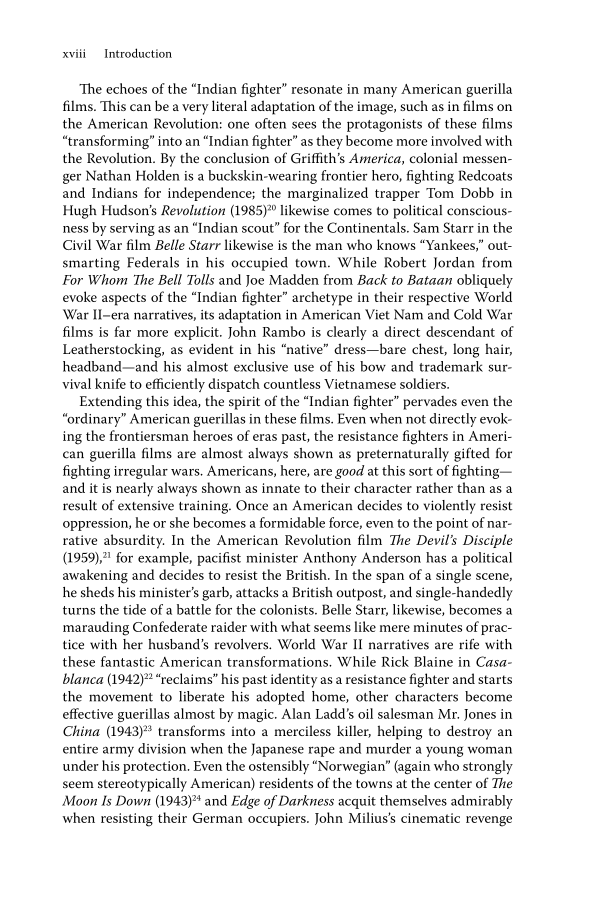xviii Introduction Th e echoes of the “Indian fi ghter” resonate in many American guerilla fi lms. Th is can be a very literal adaptation of the image, such as in fi lms on the American Revolution: one often sees the protagonists of these fi lms “transforming” into an “Indian fi ghter” as they become more involved with the Revolution. By the conclusion of Griffi th’s America , colonial messen- ger Nathan Holden is a buckskin-wearing frontier hero, fi ghting Redcoats and Indians for independence the marginalized trapper Tom Dobb in Hugh Hudson’s Revolution (1985) 20 likewise comes to political conscious- ness by serving as an “Indian scout” for the Continentals. Sam Starr in the Civil War fi lm Belle Starr likewise is the man who knows “Yankees,” out- smarting Federals in his occupied town. While Robert Jordan from For Whom Th e Bell Tolls and Joe Madden from Back to Bataan obliquely evoke aspects of the “Indian fi ghter” archetype in their respective World War II–era narratives, its adaptation in American Viet Nam and Cold War fi lms is far more explicit. John Rambo is clearly a direct descendant of Leatherstocking, as evident in his “native” dress—bare chest, long hair, headband—and his almost exclusive use of his bow and trademark sur- vival knife to effi ciently dispatch countless Vietnamese soldiers. Extending this idea, the spirit of the “Indian fi ghter” pervades even the “ordinary” American guerillas in these fi lms. Even when not directly evok- ing the frontiersman heroes of eras past, the resistance fi ghters in Ameri- can guerilla fi lms are almost always shown as preternaturally gifted for fi ghting irregular wars. Americans, here, are good at this sort of fi ghting— and it is nearly always shown as innate to their character rather than as a result of extensive training. Once an American decides to violently resist oppression, he or she becomes a formidable force, even to the point of nar- rative absurdity. In the American Revolution fi lm Th e Devil’s Disciple (1959), 21 for example, pacifi st minister Anthony Anderson has a political awakening and decides to resist the British. In the span of a single scene, he sheds his minister’s garb, attacks a British outpost, and single-handedly turns the tide of a battle for the colonists. Belle Starr, likewise, becomes a marauding Confederate raider with what seems like mere minutes of prac- tice with her husband’s revolvers. World War II narratives are rife with these fantastic American transformations. While Rick Blaine in Casa- blanca (1942) 22 “reclaims” his past identity as a resistance fi ghter and starts the movement to liberate his adopted home, other characters become eff ective guerillas almost by magic. Alan Ladd’s oil salesman Mr. Jones in China (1943) 23 transforms into a merciless killer, helping to destroy an entire army division when the Japanese rape and murder a young woman under his protection. Even the ostensibly “Norwegian” (again who strongly seem stereotypically American) residents of the towns at the center of Th e Moon Is Down (1943) 24 and Edge of Darkness acquit themselves admirably when resisting their German occupiers. John Milius’s cinematic revenge
Document Details My Account Print multiple pages
Print
You have printed 0 times in the last 24 hours.
Your print count will reset on at .
You may print 0 more time(s) before then.
You may print a maximum of 0 pages at a time.


















































































































































































































































